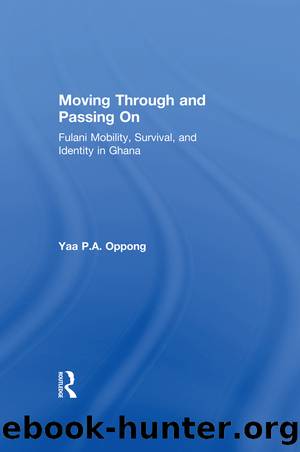Moving Through and Passing On by Yaa P.A. Oppong

Author:Yaa P.A. Oppong [Oppong, Yaa P.A.]
Language: eng
Format: epub
Tags: Social Science, Anthropology, General, Cultural & Social
ISBN: 9781351504331
Google: ZCRBDwAAQBAJ
Barnesnoble:
Goodreads: 10514062
Publisher: Routledge
Published: 2002-05-31T00:00:00+00:00
Although an equal number of girls and boys, in the 5-9 year old category, moved away from living with their parents (twenty-four), their places of residence were markedly different. For the boys, the single most significant person with whom they resided was a mallam (eight boys). The boys were also with grandparents (seven) and parentsâ siblings (five). For the girls, the homes of grandparents and parentsâ siblings are the most typical residential contexts in which they live between the ages 5-9.
By the 10-14 year old age group, thirty-three boys lived away from their parents. Of the girls, forty-five, representing nearly half of all the girls, lived outside their natal home. The boys in this age category resided primarily in the same environments (as they were in the previous age group), namely, with grandparents, parentsâ siblings and mallams. The girls in this age category started to get married, seven girls lived with their spouses. The majority of those who resided away from their parents, however, lived with their parentsâ siblings (sixteen girls) with their grandparents (nine girls) and with their own siblings (seven girls).
In the 15-19 year old age group two-thirds of girls (fifty-five) married and went to live with their spouses. Only twenty-six of them still resided with their parents. The residential profile for the boys in the 15-19 age group however is not greatly different from that of the 10-14 group.
In the 20-24 year old age category the numbers of men and women who resided with their parents was thirty-nine and five, respectively. For the men, this was still the largest single category of residence. For the girls, the single most important residential location, during this period, was with their husbands (sixty-two girls). For the men, residence with spouse does not become significant until the 25-494 age group onwards. The second most common category of residence for the men in this age group was âalone.â Twenty-seven men lived alone.
The numbers of men living âaloneâ increased dramatically in the next age group, namely the 25-49 year old group. Forty-three men lived by themselves during much of this time. The other significant residential category for the men is residence with a spouse, representing twenty-three men.
Download
This site does not store any files on its server. We only index and link to content provided by other sites. Please contact the content providers to delete copyright contents if any and email us, we'll remove relevant links or contents immediately.
Chaco's Northern Prodigies : Salmon, Aztec, and the Ascendancy of the Middle San Juan Region after AD 1100 by Paul F. Reed(355)
Law Enforcement Interpersonal Communication and Conflict Management by Brian Douglas Fitch(347)
Digital International Relations by Unknown(345)
Critical Perspectives on Human Security : Rethinking Emancipation and Power in International Relations by David Chandler; Nik Hynek(329)
Skilled interpersonal communication: Research, theory and practice, Fifth edition by Owen Hargie(326)
The Enduring Color Line in U.S. Athletics by Krystal Beamon Chris M. Messer(324)
Evidence-Based Policy Making in Labor Economics by Hamermesh Daniel S.;Nottmeyer Olga K.;Nottmeyer Olga;King Sarah;King Sarah;King Sarah;(297)
EPSO CAST Political affairs EU policies: How to succeed in the selection procedure by Franco Reverte José María(290)
Writing Public Policy - A Practical Guide to Communicating in the Policy Making Process by Catherine F. Smith(272)
Criminological Theory in Context by John Martyn Chamberlain(269)
Tibeton Yoga Its Secret Doc by Evans-Wentz(266)
Threshold Concepts in Women's and Gender Studies by Christie Launius Holly Hassel(263)
Rothschild and Early Jewish Colonization in Palestine (Geographical Perspectives on the Human Past) by Ran Aaronsohn(263)
Positive Psychology and Spirituality in Counselling and Psychotherapy (Conflict, Ethics, and Spirituality, 12) by unknow(261)
Social Problems, Social Issues, Social Science by James Wright(259)
Play in child development and psychotherapy: toward empirically supported practice by Sandra W. Russ(252)
Cognitive Development in Infancy and Childhood (Elements in Child Development) by Mary Gauvain(252)
Latin American Politics and Society by Gerardo L. Munck & Juan Pablo Luna(223)
What Makes a Social Crisis?: The Societalization of Social Problems by Jeffrey C. Alexander(220)
